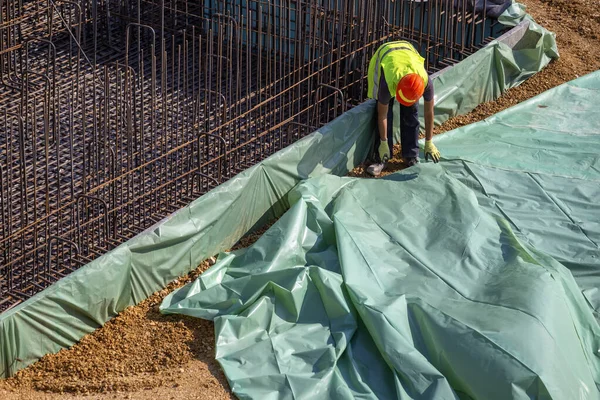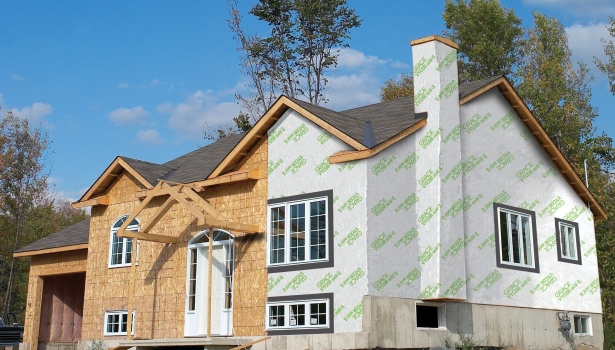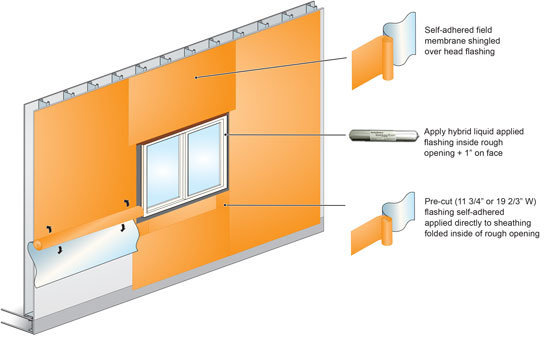For homeowners, protection against moisture and condensation is a primary concern, considering the amount of damage and deterioration it can cause. Many people use weather or vapor barriers to ensure a safe and comfortable home, but what’s the difference? Is one better than the other? And do you need both?
Let’s explore the differences between a weather barrier vs vapor barrier to help you make an informed decision on what’s best for your home. From their functions to installation and cost, here’s a breakdown of everything you need to know.
What Is Vapor Barrier?
The vapor barrier is an impermeable membrane used to reduce the amount of water vapor that can pass through walls and ceilings. Vapor barriers are commonly made from polyethylene plastic and are designed to stop water vapor from getting into insulation, thereby preventing mold growth and other moisture-related problems.
Concerning the building envelope, vapor diffusion and the second law of thermodynamics means that bulk water will likely flow from an area of higher vapor pressure in the colder outside environment into warmer building cavities. A vapor barrier should be installed on the warm side of insulation or wall assemblies during construction to prevent this. This helps control moisture movement by blocking it from entering the warmer interior.
Vapor Retarder Vs. Vapor Barrier
For many years, the terms ‘vapor retarder’ and ‘vapor barrier’ were used interchangeably. However, there is an important difference between the two in their ability to control air movement. A vapor retarder is a material that slows the rate at which water vapor can pass through it, while a vapor barrier is a material that completely stops the passage of water vapor. To determine which class an item falls into, ASTM E 96 tests measure the material’s ability to restrict moisture movement.
- Class I is considered a true vapor barrier because it has a perm rating of 0.1 or less, meaning it does not allow any vapor to pass through it.
- Class II and III materials are considered vapor retarders because they have a perm rating of between 0.1 and 10, allowing some moisture transmission.
Historically, the placement of vapor barriers (typically polyethylene) was on the interior wall and ceiling insulation to prevent condensation from occurring due to air movement between a home’s interior and exterior surfaces. However, due to the advancement in building materials, vapor retarders are now more commonly used. They still protect against condensation while allowing moisture to escape from within walls.
Do Wall Systems Need Vapor Barriers?
When constructing walls, most people think of weatherproofing and insulation first. But what about vapor barriers? Are they necessary?
The answer is ‘it depends’. Sometimes, a vapor barrier can be beneficial if there is too much moisture in the air. A vapor barrier controls this by providing an effective layer of protection against moisture from entering a wall system and causing damage over time.
However, as the 2018 study in Denmark concluded, vapor diffusion does not play a significant role in most cases of moisture intrusion into walls. This has led many experts to consider vapor barriers unnecessary if proper insulation and weatherproofing techniques are used.
Problems With Vapor Barriers
If moisture can seep into the wall system and get past the vapor barrier, it can become trapped in the insulation. This will lead to condensation of moisture, which can be damaging to your home and its occupants. This includes damage to walls, floors, ceilings, and any other parts of the house that are in contact with the air-conditioned space. If a vapor barrier is installed incorrectly, it can become ineffective in blocking moisture and lead to further damage.
Also, for the vapor barrier to be effective, it must be completely sealed and airtight. Even small gaps in the seal can allow moisture to pass through, leading to further damage within the wall system.

Code Requirements For Vapor Barriers
Depending on the local climate, code requirements for vapor barriers vary. In Zone 5 and above, a class I or II vapor barrier is required on the interior of frame walls. Class I vapor retarders are defined as materials having a permeance rating of 0.1 perms or less, while Class II vapor retarders have a higher permeance rating between 0.1 and 1.0 perm.
Meanwhile, southern climate zones 1, 2, and 3 do not require the use of vapor barriers due to less risk for moisture accumulation within the walls caused by high humidity levels. In these zones, the use of weather barriers is considered to be sufficient. IRC R702.7, the code requirement for moisture barrier, states that houses in these zones must have a water-resistant barrier behind the exterior cladding material, such as siding or brick, to protect against moisture intrusion.
What Is A Weather Barrier?
As per the International Energy Conservation Code (IECC®) 2018, a weather barrier is a continuous material used to restrict or prevent the seepage of air from outside through the building’s thermal envelope and its components. The air permeance of a barrier should not exceed 0.02 L/(s·m²) at a pressure difference of 75 Pa (0.004 cfm/ft2 with air pressure differences of 1.56 lb/ft2) when tested as per ASTM E 2178. Air permeance is the measure of air that passes through a material, while air leakage is the amount of air that seeps through crevices and holes.
What’s The Purpose?
Regulating your home’s indoor climate is the primary purpose of an effective air barrier. It stops the transfer of both hot and cold air and the moisture associated with it between the interior and exterior of a structure. Additionally, a quality air barrier must be able to resist different air pressures that act upon it.
One key element when trying to keep your home’s indoor climate comfortable is to prevent warm air and moisture from entering the walls of a structure, as once it touches the cool interior wall, condensation can form. Your air barrier will limit heat loss or gains by conduction, convection, and radiation.
- Conduction: To understand this, think of the molecules in warmer areas moving towards cooler ones. This will affect the R-value of your building’s wall system and its resistance to conduction.
- Convection: The flow of heat energy from a warmer space to a much cooler one is achieved through the movement or flow of fluids (like liquids and gases).
- Radiation: Electromagnetic waves transfer heat from a warmer to a cooler space. This is mainly the sun’s radiation that does this job.

Basic Requirements Of Air Barriers
To ensure a successful and continuous air barrier system, key components of air barriers include longevity, integrity, adhesion and drainage. The details include the following:
- Durability: An air barrier must have the strength, durability and longevity to resist forces that may act on it during construction. It must also be able to withstand exposure to UV radiation, extreme temperatures and other weather-related conditions over the expected life of a building envelope.
- Integrity: A successful air barrier system must be impermeable to airflow and maintain its integrity over time. It should remain intact, offering a continuous layer of protection against the infiltration of outside air and moisture and prevent air leaks.
- Adhesion: The air barrier components must properly adhere to adjacent materials such as wall sheathing, insulation blankets, framing members and other building materials, creating an uninterrupted seal that prevents outdoor air from entering the building envelope.
- Drainage: An effective air barrier should provide for the draining of condensation and other forms of moisture, allowing it to exit the building envelope without creating an environment conducive to mold or rot.
Types Of Weather Barriers
Several different materials can be used to create a weather barrier. These materials range from foam board, plastic film, and roofing membranes to plywood and building wrap. The type of material chosen depends on the application and its primary purpose.
- Nylon Film: Nylon film is a thin polyester or polypropylene material that helps keep moisture out of a structure. It’s easy to install and can be used on various surfaces, including walls, attics, basements and crawl spaces.
- Polyethene Film: Polyethylene is lightweight, highly durable, and offers great protection against wind, rain, and moisture. It is often used on commercial and residential buildings, including mobile homes, RVs, and sheds.
- Building Wrap: Building wrap is a breathable synthetic material, allowing moisture to escape while also serving as a barrier against wind and water infiltration. It’s an excellent choice for areas with high humidity or a water damage risk.
- Roofing Membrane: Roofing membranes are waterproof, highly durable materials that can be installed on flat or pitched roofs. They provide superior protection against water infiltration and help protect against hail, snow, and other weather-related damage.
- Self-Adhering Asphalt Roofing Membrane: A self-adhering asphalt roofing membrane is a great choice to deal with extreme weather conditions. It’s composed of two layers: an asphalt layer that adheres to the surface and a non-asphalt layer that offers protection from moisture and wind.
- Built-Up Modified Asphalt Roof: Built-up, modified asphalt roofs are composed of multiple layers of asphalt, tar, and other materials. With this type of roof, the outermost layer is usually a reflective material that helps keep temperatures comfortable.
- Plywood: Plywood is often used in construction projects to provide extra strength and rigidity. A weather barrier can also be a moisture and air barrier to prevent water from entering the structure.
- Extruded Polystyrene Board: Extruded polystyrene board is a foam insulation material that protects against moisture and temperature changes. It helps keep heat in during the winter months and out during the summer months, providing an effective weather barrier.
Code Requirements For Weather Barriers
- Residential Buildings: The 2018 IRC (Table R402.4.1.1) mandates a continuous weather-resistant barrier be included in the building envelope for all climate zones except 2B and 3A. A material meeting ASTM E-96 water resistance requirements should be used to create this barrier, consisting of two layers of building paper, one layer of building paper with a plastic sheeting or sheathing, or another approved material. Along with these requirements, all breaks or joints in this barrier must be sealed to provide effective weather protection.
- Commercial Buildings: The 2018 IBC (Section C402.5.2) requires a continuous weather-resistant barrier in the building envelope for all climate zones. This barrier must consist of two layers of building paper, one layer with plastic sheeting, sheathing, or any other approved material that meets ASTM E-96 water resistance requirements. As per the code, it can be located on either the inside or outside of the building envelope and must be sealed at all joints to provide effective protection against water penetration.

FAQs
1. Do I Need Both A Weather Barrier And A Vapor Barrier?
Depending on your home’s local climate and building materials, you may need both a weather barrier and a vapor barrier to protect it from moisture. Generally, both types of barriers are required in climates with cold winters. In warmer climates, one type of barrier may provide sufficient protection.
One vapor barrier is usually appropriate for wall assembly, but multiple air barriers can be used. A vapor barrier can also be a strong air barrier. However, it should only sometimes stop moisture from passing through. An air barrier is meant to limit the amount of airflow and keep out external elements, whereas a vapor barrier helps reduce internal condensation by preventing water molecules from permeating.
2. Is A Vapor Barrier The Same As An Insulation Barrier?
No. A vapor barrier keeps water out, whereas insulation is meant to contain it. While some types of insulation can act as a vapor barrier, they are not the same. For instance, fiberglass insulation does not stop all moisture from passing through and should be paired with a vapor barrier.
3. Can I Use A Vapor Barrier On The Roof?
Yes. You can use a vapor barrier on the roof of your home. However, it is only sometimes necessary. If you live in a cold climate and have a poorly insulated attic, installing a vapor barrier can help keep your home more energy-efficient by reducing condensation. However, it may be optional if you live in an area with warm summers.


